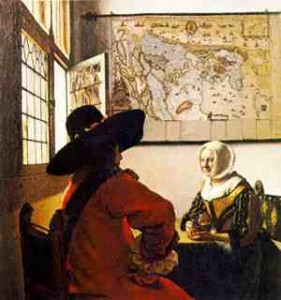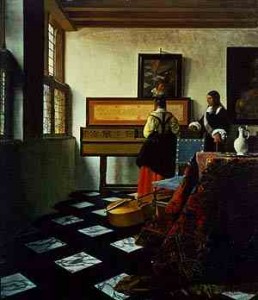Art Sunday: Mysteries in Art
The Mystery in the Mirror
Vermeer’s Camera
This painting called, ‘Lady at the Virginals with a gentleman”, was created by the great Dutch artist Johannes Vermeer in the 1660s. It shows an exquisitely painted interior scene, with a woman playing a keyboard and a man listening. The woman has her back to us, although we can see a reflection of her face in the mirror on the wall. The man’s role is unclear. He appears to be wearing an outdoor coat, and is carrying a stick. Has he just stepped inside from the street, to ask the woman a question, and now hangs on her answer? Is he a relation? Her teacher? Her lover? The answer to this little mystery we may never know. But this painting contains a quite extraordinary set of clues about a much bigger mystery, one which has only recently been deciphered.
 Vermeer (1632-75) produced about 30 paintings during his lifetime. When he died, his wife and family were left in debt. Two paintings went to the local baker to settle a bill. But since about 100 years ago, his work started to be re-assessed, and today he is regarded as one of the greatest artists that ever lived.
Vermeer (1632-75) produced about 30 paintings during his lifetime. When he died, his wife and family were left in debt. Two paintings went to the local baker to settle a bill. But since about 100 years ago, his work started to be re-assessed, and today he is regarded as one of the greatest artists that ever lived.
Very little is known about Vermeer’s life, and his methods of working. He had no students or apprentices, and he left no records. But many people have speculated that he might have used some sort of optical device to help him create his paintings, possibly a device called a Camera obscura, the forerunner of the modern camera. Literally ‘darkened room’ a Camera obscura is a box which has a lens at the front. A portable Camera obscura can have a ground glass screen onto which the image from the lens is thrown. Or a Camera obscura can be big enough for the observer to be inside it.
These speculations about Vermeer’s possible use of a Camera obscura are based on general observations about his paintings. Some think of Vermeer in the same context as those scientific geniuses of the 17th century, the microscopist van Leeuwenhoek, who turned his lens on the miniature world contained in a drop of water, and Galileo, who turned his telescope to the heavens.
Reasons for thinking Vermeer used a camera obscura
 This painting by Vermeer is entitled ‘Soldier and Laughing Girl’. In 1891 the American etcher and lithographer James Pennell was the first to suggest that Vermeer might have used a Camera obscura, in an article written for the Journal of the Camera Club. Pennell referred to the ‘photographic perspective’ of pictures such as this one, where the figure of the soldier, in the foreground, is disproportionately large. We think nothing of this shot today, the perspective is quite correct for the ‘close up’ viewpoint, just the sort of picture you might take with a camera. But for a 17th century painting, this perspective would have seemed unusual.
This painting by Vermeer is entitled ‘Soldier and Laughing Girl’. In 1891 the American etcher and lithographer James Pennell was the first to suggest that Vermeer might have used a Camera obscura, in an article written for the Journal of the Camera Club. Pennell referred to the ‘photographic perspective’ of pictures such as this one, where the figure of the soldier, in the foreground, is disproportionately large. We think nothing of this shot today, the perspective is quite correct for the ‘close up’ viewpoint, just the sort of picture you might take with a camera. But for a 17th century painting, this perspective would have seemed unusual.
Secondly, some of the maps that are shown hanging on the back wall of the room in the paintings are real maps that Vermeer owned, and which still exist today. The historian James Welu (1975) showed just how precisely Vermeer had copied the originals. The Camera obscura was certainly used in the 18th and 19th centuries for copying existing pictures and prints, making his paintings as accurately detailed as photographs.
|
strongwilledwoman wrote on Jan 26, ’08
Very interesting. Thanks for the information.
|
|
wickedlyinnocent wrote on Jan 26, ’08
Vermeer and the “camera obscura”, very interesting subject. Laurita, if you like mystery fiction mixed with historical novel there’s a book “The Apothecary’s House”, about works of art stolen by the nazis, a mysterious painting and the technique of the camera obscura. The author is Adrian Mathews and the heroine works at the Rijksmuseum in Amsterdam and lives in a boat, which is different from other detective stories.
|
|
lauritasita wrote on Jan 26, ’08
Thank you for your recommendation of the book, “The Apothecary’s House.” I will look for it. Sounds interesting, too !
|
|
aimlessjoys wrote on Jan 27, ’08
Very interesting. Enjoyed!
|
|
lauritasita wrote on Jan 27, ’08
It seems that Leonardo Da Vinci is not the only artist that has a mystery surrounding him.
|


Comments
Art Sunday: Mysteries in Art — No Comments
HTML tags allowed in your comment: <a href="" title=""> <abbr title=""> <acronym title=""> <b> <blockquote cite=""> <cite> <code> <del datetime=""> <em> <i> <q cite=""> <s> <strike> <strong>